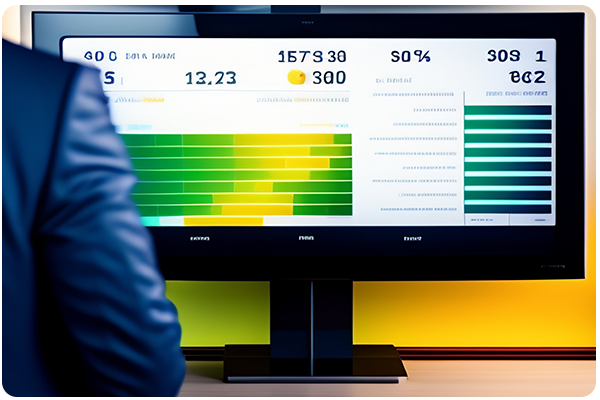Location Intelligence vs. Business Intelligence: What's the Difference

- Introduction
The terms "Location Intelligence" and "Business Intelligence" are frequently used but often misunderstood. These two concepts play pivotal roles in helping organizations make data-driven decisions and gain a competitive edge in their respective industries. However, they serve different purposes and offer distinct insights. In this comprehensive guide, we will delve deep into Location Intelligence (LI) and Business Intelligence (BI), highlighting their differences, capabilities, and real-world applications. By the end, you'll have a clear understanding of when and how to leverage each of these powerful tools to enhance your business operations.
- The Significance of Data in Modern Business
- The Evolution of Business Intelligence
- The Emergence of Location Intelligence
In today's digital age, data is the lifeblood of businesses across the globe. Organizations of all sizes are amassing vast amounts of information about their operations, customers, and markets. Harnessing this data for informed decision-making has become a critical factor for success. This is where Business Intelligence (BI) and Location Intelligence (LI) come into play.
Business Intelligence, often referred to as BI, has been a cornerstone of data-driven decision-making for several decades. It encompasses a range of processes, technologies, and tools that analyze and transform raw data into actionable insights. BI solutions enable organizations to track key performance indicators (KPIs), generate reports, and create visualizations to aid in strategic planning.
Location Intelligence, on the other hand, is a more recent development that has gained prominence with the proliferation of geospatial data and technology. It extends the capabilities of traditional BI by incorporating location-based or spatial data into the decision-making process. LI empowers organizations to not only understand what is happening but also where it is happening.
Now that we've set the stage, let's dive deeper into the realms of BI and LI.
- 1. Defining Business Intelligence (BI)
- Understanding Business Intelligence
- BI Components and Functionality
- BI in Action: Real-World Examples
Business Intelligence, at its core, is a comprehensive set of processes, architectures, and technologies that transform raw data into meaningful information to support business decision-making. The primary objective of BI is to provide historical, current, and predictive views of business operations.
BI solutions encompass a wide range of functionalities, including data integration, data warehousing, data analytics, data visualization, and reporting. These capabilities collectively enable organizations to access, analyze, and present data in a way that helps stakeholders make informed choices.
Data Integration: BI starts with data integration, where information from various sources within an organization is collected, cleaned, and integrated into a single data repository. This process ensures that the data used for analysis is accurate and consistent.
Data Warehousing: Data warehousing involves storing data in a structured and optimized format for easy retrieval and analysis. Data warehouses are designed to support reporting and analysis efficiently.
Data Warehousing: Data warehousing involves storing data in a structured and optimized format for easy retrieval and analysis. Data warehouses are designed to support reporting and analysis efficiently.
Data Visualization: Data visualization tools create graphical representations of data, making it easier for users to grasp complex information. Dashboards, charts, graphs, and heat maps are common visualization techniques.
Reporting: Reporting functionalities generate predefined or ad-hoc reports based on the analyzed data. Reports can be in the form of tables, charts, or narratives.
To better understand the practical applications of Business Intelligence, let's consider a few real-world scenarios:
Sales Analysis: A retail company uses BI to analyze sales data to identify trends, determine which products are performing well, and make decisions about inventory management.
Financial Reporting: A financial institution employs BI to consolidate data from various branches, generate financial reports, and monitor risk factors in real-time.
Customer Insights: An e-commerce platform utilizes BI to analyze customer behavior, segment customers based on buying patterns, and personalize marketing campaigns.
Supply Chain Optimization: A manufacturing company leverages BI to optimize its supply chain by monitoring production processes, predicting maintenance needs, and identifying cost-saving opportunities.
A manufacturing company leverages BI to optimize its supply chain by monitoring production processes, predicting maintenance needs, and identifying cost-saving opportunities.
- 2. Exploring Location Intelligence (LI)
- The Essence of Location Intelligence
- Spatial Data and Geospatial Analysis
- Location Intelligence in Practice
Location Intelligence, often referred to as LI, is an innovative approach to data analysis that integrates spatial or geographic information into the decision-making process. It involves the collection, analysis, and visualization of data within the context of its location.
LI extends the capabilities of traditional BI by providing insights into the "where" aspect of data. It answers questions related to location, proximity, and spatial relationships. This can be particularly valuable for organizations whose operations are influenced by geographic factors, such as retail chains, logistics companies, and real estate developers.
At the core of Location Intelligence lies spatial data. Spatial data, also known as geospatial data, includes information tied to specific geographic locations. This data can come from various sources, including GPS devices, satellite imagery, geographic information systems (GIS), and more.
Geospatial analysis is the process of examining and interpreting data to understand how features, phenomena, and patterns are distributed across space. It involves techniques like spatial querying, spatial statistics, and spatial modeling.
The practical applications of Location Intelligence are diverse and far-reaching. Here are a few examples:
Retail Site Selection: A retail chain uses LI to analyze demographic data, foot traffic patterns, and competitor locations to determine the ideal location for a new store.
Emergency Response: Public safety agencies employ LI to optimize emergency response times by analyzing the location of incidents, the availability of resources, and traffic conditions.
Environmental Conservation: Environmental organizations utilize LI to monitor and protect natural habitats by tracking changes in land use, wildlife migration patterns, and the impact of climate change.
Real Estate Development: Environmental organizations utilize LI to monitor and protect natural habitats by tracking changes in land use, wildlife migration patterns, and the impact of climate change.
Location Intelligence adds a spatial dimension to data analysis, enabling organizations to make location-based decisions, enhance operational efficiency, and gain a competitive advantage. However, it's important to understand the distinctions between Business Intelligence and Location Intelligence.

- 3. Key Differences Between BI and LI
Focus and Purpose
- 1. Business Intelligence (BI):
1. Focuses on analyzing historical, current, and predictive data to support general business decision-making.
2. Emphasizes understanding "what" is happening within an organization.
3. Provides insights into sales, finance, customer behavior, and internal operations.
- 2. Location Intelligence (LI):
1. Incorporates spatial or geographic data into the decision-making process.
2. Emphasizes understanding "where" events, trends, or phenomena are occurring.
3. Provides insights into geographic patterns, site selection, and spatial relationships.
Data Types and Sources
- 1. Business Intelligence (BI):
1. Utilizes structured data from various internal sources such as databases, ERP systems, and CRM systems.
2. Focuses on structured data like sales figures, financial records, and customer profiles.
- 2. Location Intelligence (LI):
1. Integrates structured and unstructured data, including geospatial data from sources like GPS,
satellite imagery, and GIS.
2. Focuses on both structured data (e.g., customer addresses) and unstructured data
(e.g., location-based social media posts).
Decision-Making Scope
- 1. Business Intelligence (BI):
1. Supports a broad spectrum of business decisions, from strategic planning to operational improvements.
2. Aids in optimizing internal processes and resource allocation.
- 2. Location Intelligence (LI):
1. Primarily assists in location-specific decisions and scenarios.
2. Helps organizations make decisions related to site selection, route planning, and geographic trends.
Industry Applications
- 1. Business Intelligence (BI):
1. Widely applicable across various industries, including finance, healthcare, manufacturing, and retail.
2. Used for general data analysis and reporting.
- 2. Location Intelligence (LI):
1. Particularly beneficial for industries influenced by geographic factors, such as retail, real estate, logistics,
and emergency services.
2. Specialized in spatial analysis, geographic information systems, and map-based visualizations.
Understanding these key differences is essential for organizations aiming to leverage the strengths of both BI and LI.
- 4. The Synergy of BI and LI
Use Cases of BI and LI Integration
-
Retail Analytics: Imagine a retail chain that uses Business Intelligence to analyze sales trends across its stores. By integrating Location Intelligence, it can superimpose these trends onto maps, revealing spatial patterns and helping identify factors contributing to the success or underperformance of specific locations.
-
Supply Chain Optimization: A logistics company relies on Business Intelligence to track its supply chain's efficiency. Location Intelligence can be employed to optimize routes by considering real-time traffic data, weather conditions, and geographically specific challenges.
-
Real Estate Development: A logistics company relies on Business Intelligence to track its supply chain's efficiency. Location Intelligence can be employed to optimize routes by considering real-time traffic data, weather conditions, and geographically specific challenges.
-
Emergency Response: A logistics company relies on Business Intelligence to track its supply chain's efficiency. Location Intelligence can be employed to optimize routes by considering real-time traffic data, weather conditions, and geographically specific challenges.
In these examples, the integration of BI and LI augments decision-making processes by providing a comprehensive view that combines traditional business insights with location-based considerations.
- 5. Selecting the Right Tool for Your Business
Factors to Consider
-
When deciding whether to implement Business Intelligence (BI), Location Intelligence (LI), or a combination of both in your organization, several factors should be taken into account:
-
Business Objectives: Clearly define your organization's goals and determine whether they are primarily location-specific or require broader data analysis.
-
Data Sources: Evaluate the types of data your organization generates and collects. If you deal with geospatial data or unstructured location-based data, LI may be particularly relevant.
-
Industry: Consider the industry in which your organization operates. Some industries, like real estate and logistics, are inherently location-dependent and can benefit greatly from LI.
-
Budget and Resources: Assess your budget constraints and the availability of resources, including specialized skills required for LI implementation.
-
Scalability: Think about your organization's future growth and whether your chosen solution can scale to meet evolving needs.
Industry-Specific Considerations
-
Retail:
BI: Valuable for inventory management, sales forecasting, and customer analytics.
LI: Essential for site selection, visualizing foot traffic, and optimizing store layouts.
-
Healthcare:
BI: Useful for patient data analysis, resource allocation, and operational efficiency.
LI: Critical for analyzing disease outbreaks, patient demographics, and hospital location planning.
-
Real Estate:
BI: Beneficial for market analysis, property pricing, and customer profiling.
LI: Crucial for assessing property location, land suitability, and urban development.
-
Logistics:
BI: Helpful for supply chain optimization, route planning, and inventory management.
LI: Vital for tracking vehicle locations, monitoring traffic conditions, and optimizing delivery routes.
-
Emergency Services:
BI: Supports resource allocation, incident reporting, and response time analysis.
LI: Enhances emergency response by considering geographic factors, such as incident location and resource proximity.
- 6. Challenges and Limitations
Addressing Common Issues
-
No technology solution is without its challenges. Business Intelligence (BI) and Location Intelligence (LI) are no exceptions. Some common issues organizations encounter include:
-
Data Quality: Ensuring that the data used for analysis is accurate and up to date can be a significant challenge. Dirty data can lead to incorrect conclusions.
-
Complexity: Implementing BI or LI systems can be complex, requiring specialized skills and technologies. Organizations may face difficulties in finding and retaining qualified personnel.
-
Integration: Integrating BI and LI with existing systems can be challenging. Data silos, incompatible formats, and legacy systems can hinder seamless integration.
-
Cost: Implementing and maintaining BI and LI solutions can be costly, especially for smaller organizations with limited budgets.
Overcoming Data Quality Concerns
-
To address data quality concerns, organizations should establish robust data governance practices. This includes data validation, cleansing, and regular audits to ensure data accuracy. Additionally, implementing data quality tools and processes can help maintain clean and reliable datasets.
Future Trends in BI and LI
The fields of Business Intelligence and Location Intelligence continue to evolve. Some emerging trends to watch for include:
-
AI and Machine Learning Integration: Both BI and LI are increasingly incorporating AI and machine learning algorithms to automate data analysis and gain deeper insights.
-
Cloud-Based Solutions: The adoption of cloud-based BI and LI solutions is on the rise due to their scalability and accessibility advantages.
-
Real-Time Analytics: Organizations are moving towards real-time data analytics to make quicker, more informed decisions.
-
IoT Integration: As the Internet of Things (IoT) expands, BI and LI will play a crucial role in analyzing and visualizing data from connected devices.
- 7. Conclusion
Recap of Key Takeaways
-
In this comprehensive guide, we've explored the realms of Business Intelligence (BI) and Location Intelligence (LI). We've uncovered their distinct purposes, functionalities, and applications. Key takeaways include:
-
BI focuses on general data analysis for informed decision-making, while LI incorporates spatial data to answer location-specific questions.
-
BI primarily deals with structured data from internal sources, whereas LI integrates both structured and unstructured geospatial data.
-
Organizations should consider their business objectives, data sources, industry, budget, and scalability when choosing between BI, LI, or a combination.
-
The synergy of BI and LI enhances decision-making by combining traditional business insights with location-based considerations.
-
Challenges in data quality, complexity, integration, and cost can be overcome with effective data governance and planning.
-
Future trends in BI and LI include AI integration, cloud-based solutions, real-time analytics, and IoT connectivity
The Path Forward: Maximizing Data Insights
-
As businesses continue to accumulate vast amounts of data, the ability to extract meaningful insights from that data becomes increasingly critical. Business Intelligence and Location Intelligence are indispensable tools for organizations seeking to thrive in an era defined by data-driven decision-making.
-
The choice between BI and LI—or a strategic blend of both—should align with your organization's unique objectives and needs. By making informed choices in this regard, you can chart a course toward data-driven success in your industry.
-
In the end, it's not a matter of Location Intelligence vs. Business Intelligence; it's about harnessing the power of both to unlock the full potential of your data.
- References
-
[1] Davenport, T. H., & Harris, J. (2007). Competing on analytics: The new science of winning. Harvard Business Press.
-
[2] Wise, S., & Craglia, M. (2009). GIS and evidence-based policy. Environment and Planning B: Planning and Design, 36(5), 773-777.
-
[3] Oracle. (2023). Business Intelligence (BI). Retrieved from https://www.oracle.com/business-analytics/business-intelligence/


